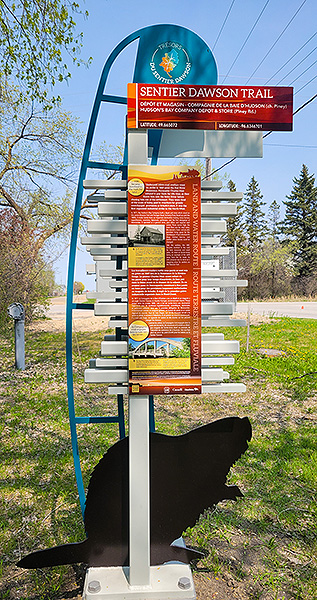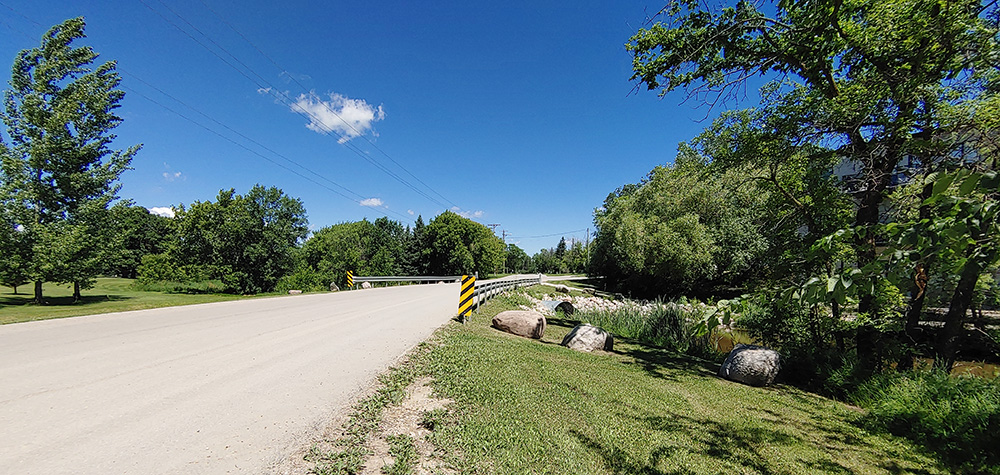POINT OF INTEREST:
Commemorative Marker #9 | Old Finnigan Bridge
The Fur Trade in Eastern Manitoba | HBC Post and Shelter for Travellers
Sir Sanford Fleming's Expedition - Journal Excerpt (1872)
HISTORICAL NUGGETS: "A Most Beautiful Country"
Mennonite Delegates in Sainte-Anne (1873)
 Commemorative Marker #9
Commemorative Marker #9
SEE GOOGLE MAP LOCATION 
Theme: HBC Post / Rise of the Red River Resistance
From the park retrace your route back to Dawson Road #207 and turn right (east). Proceed for 500 metres and turn right (south) on Finnigan Road.
The marker is located at the corner of Dawson Road and Finnigan Road.
If you then continue south you will see the river where old Finnigan Bridge used to stand. Return to #207 Dawson Road when done.
Old Finnigan Bridge
The Old Hudson's Bay Company Post stood just southeast of the corner of Dawson Trail and Finnigan Road.
Unfortunately there is nothing left to see at this site as it has since been built over.
Just south of this on Finnigan Road lies Finnigan Bridge. Old Finnigan Bridge was a beautiful concrete bowstring arch bridge over the Seine River and was a municipally-designated historic site for many years.
However it became unsafe in 2012 and what you see today is the new replacement bridge in the same location.

The Old Piney Bridge now Finnigan Bridge, June 2013. This 50-foot concrete bowstring arch bridge over the Seine River was completed in 1921 at a cost of $13,678 borne equally by the provincial and municipal governments. It was designated as a municipally-significant historic site in 1987. It was used for local traffic until it was closed to all by pedestrians and cyclists in 2012. Its heritage status was revoked in early 2013, and the bridge was later demolished. Source: Manitoba Historical Society. (2020, March 26). Historic Sites of Manitoba: Concrete Bowstring Arch Bridge (Seine River, Finnigan Road, Ste. Anne). Retrieved June 30, 2020 from http://www.mhs.mb.ca/docs/sites/pineyroadbridge.shtml Photo courtesy of Norm Lavack (photo taken 2006-05-14).

Piney Road Cement Bridge Plaque, which read: The first bridge to cross the Seine River at this location was the "Pelland Bridge", built in the mid 1800s. This was the only means in the area to cross the Seine River outside of using a boat. The original bridge was removed and replaced by the existing cement bridge in 1921. The lumber of the old bridge was used as forms for the present bridge, which was constructed of concrete and re-inforcing steel in accordance with the specifications of the engineer of the Provincial Good Roads Board.
The Rural Municipality of Ste. Anne adopted By-Law No. 125 on July 5th, 1920 authorizing the construction of the new bridge at a cost estimated at 12,000.00 dollars, of which one-half was paid by the Government of Manitoba and the balance financed with 30 year debentures at the rate of interest of 6 percent with the Bank of Hochelaga. The construction was done under the supervision of Reeve T. Mollen of the Rural Municipality of Ste. Anne. The cement bridge opened to traffic in 1921. Photo courtesy Norm Lavack.

Construction of the bridge in 1921. Photo courtesy Norm Lavack.

New Finnigan Bridge built in 2013. Photo by Myriam Dyck
The Fur Trade in Eastern Manitoba

Voyageurs at dawn en route between Lake Superior and Red River Settlement, 1871, by Frances Ann Hopkins. HBC Heritage website. Retrieved from http://www.hbcheritage.ca/people/women/frances-anne-hopkins
By the 1770s, the NorthWest Company and other Scottish and British companies trading from the Eastern colonies got in on the interior trade monopolized by the Hudson’s Bay Company since the early 1600s. They hired French-speaking habitants from New France as voyageurs or engagés to do the seasonal hauling because of their knowledge of the rivers and lakes and long-lasting relationships with First Nations in the pays d’en haut.
Over time the distances paddled got longer and longer as nearby areas to the Eastern colonies were trapped out of high quality fur-bearing animals. The distances could no longer be travelled there and back before winter freeze-up. This required some voyageurs to winter over in the North-West (they called it le Grand Nor’West). These voyageurs became known as Hommes du Nord or Nor’Westers, and Hivernants for those who were trading partners. The route these voyageurs followed from Lake Superior to Lake of the Woods would more than a hundred years later become the water segment of the Dawson Route.

Voyageurs travelling on snowshoes through the woodlands. The earliest Europeans in southeastern Manitoba were voyageurs and wintering partners known as hivernants. They married First Nations women according to the custom of the country and this was at the origins of the Métis Nation. Image source: McGill Digital Library https://digital.library.mcgill.ca/nwc/showcaption.php?lang=english&src=history/history_images/voyageurs/SM%201970-874.jpg&id=SM%201970-874
The presence of these companies in the interior became a direct threat to the Hudson’s Bay Company’s interests in the region and by the end of the 1700s, early 1800s the HBC moved its forts to the interior as well, and competition was fierce until the turbulent events leading up to their amalgamation as the HBC in 1821. During the HBC regime of 1821 to the 1840s the colony saw relative peace and thrived as several provisioning posts were established in the region to make and store pemmican supplies for voyageurs going as far as Athabasca country and beyond. It is in this period that the HBC post was established in Grande Pointe-des-Chênes (Ste. Anne) where some Métis families lived. Métis culture very much developed around bison hunting and the carting of pemmican and other provisions to forts across the NorthWest, which Métis accessed via an intricate system of overland cart trails extending from the Mississippi to the NorthWest Territories. By this point the Red River Settlement had become a highly multicultural and multilingual community. Métis of the region are known to have spoken up to six languages in conducting trade with their European and First Nations relations.
Louis Riel Institute and various other sources.
Source: Louis Riel Institute. (2020). Michif Language. Retrieved July 1, 2020 from http://www.louisrielinstitute.com/michif-language.php#:~:text=In%20the%20past%20many%20M%C3%A9tis,many%20occupations%20of%20the%20M%C3%A9tis.

Map by Aaron Arrowsmith (London: 1830), showing the departments, districts, and depots of the Hudson’s Bay Company in 1830. 1830 is around the same time the first Métis families settled in the area around Ste. Anne. The Dawson Trail went from Upper Canada, through the Lac LaPluie District to the Red River District. Redrawn by Eric Leinberger. Hudson’s Bay Company Archives, Provincial Archives of Manitoba. Source: Mackie, R. (2020, Feb 29). #742 Beyond the Great Western Peninsula. The Ormsby Review, Fur Trade. Retrieved June 30, 2020 from https://ormsbyreview.com/2020/02/09/729-mackie-fur-trade-beyond-the-great-western-peninsula/
HBC Post and Shelter for Travelers
The Hudson Bay Company built a post in the small community of Sainte-Anne-des-Chênes in the late 1860’s or early 1870’s. It served as a trading post and the post office (1872-1883). With this came a hotel and a general store and in its last years, it was a jail. It was of log construction with a powder house at back. The historic building burned down in the early 1980s. It was located at the junction of Rue Centrale (Dawson Road) and Piney Road (now Finnegan Road), where the Dayspring Church now stands.

Hudson's Bay Company post with powder house in the background. Photo courtesy of Norm Lavack.
The Hudson’s Bay store and post house sheltered many travelers passing through on the Dawson Road, providing food and lodging and a change of horses. Sir Sanford Fleming stopped here in 1872 on his expedition across Canada to find the best route for the Canadian Pacific Railway.

The Hudson Bay Company store in Ste. Anne des Chênes, also served as the first Post Office for the Town (1872-1883). This is what remained of the post circa 1890. Dawson Trail Museum collection.
Sir Sanford Fleming’s Expedition - Journal Excerpt (1872)
“At length emerging from the wooded country into the prairie, we saw the light of the station two miles ahead. Arriving there weary and soaked through, we came to what appeared to be the only building – a half finished store of the Hudson Bay Company; entering the open door barricaded with paint posts, blocks of woods, tools, etc. We climbed up a shaky ladder to the second story, threw ourselves down on the floor, and slept heavily amongst a crowd of teamsters whom no amount of kicking could awake.”
Sir Sanford Fleming on his Expedition through Canada, 1872
Source: Grant, George Monro, 1835-1902. (1873). Ocean to ocean: Sandford Fleming’s expedition through Canada in 1872 (P.62). Being a diary kept during a journey from the Atlantic to the Pacific with the expedition of the engineer-in-chief of the Canadian Pacific and Intercolonial railways. BC Historical Books. Diaries. Retrieved June 3, 2020, from https://open.library.ubc.ca/collections/bcbooks/items/1.0221770
Go to Next Tour Location: Seine River Crossing | Top
Previous page: Parc des Rédemptoristes
Next page: Seine River Crossing
